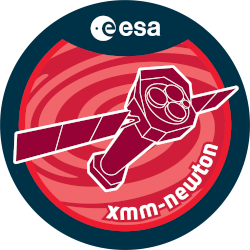

| Proposal ID | 030226 |
| Title | XMM, Spitzer, and Ground-based Observations of Seyfert 1.8 and 1.9 Galaxies |
| Download Data Associated to the proposal | https://nxsa.esac.esa.int/nxsa-sl/servlet/data-action-aio?obsno=0302260101 |
| DOI | https://doi.org/10.5270/esa-ayj2bw2 |
| Principal Investigator, PI | Prof D. Michael Crenshaw |
| Abstract | We propose XMM-Newton observations of 6 Seyfert 1.8 and 1.9 galaxies from ourapproved Spitzer program that will obtain the mid-IR spectra of these AGN. Wewill use the EPIC spectra to characterize the absorption components anddetermine their hydrogen column densities in the line of sight to the X-rayemission sources. From the X-ray determinations of gas column densities andglobal constraints (temperatures, sizes) on the circumnuclear dust regionsderived from the Spitzer spectra, we will test the clumpy torus model, and theidea that Seyfert 1.8 and 1.9 galaxies are viewed at intermediate angles withrespect to the torus axis. We will obtain groundbased optical and near-IRspectra as well, to measure the dust/gas ratio in the torus. |
| Publications |
|
| Instrument | EMOS1, EMOS2, EPN, OM, RGS1, RGS2 |
| Temporal Coverage | 2005-04-09T12:34:20Z/2006-08-21T07:22:27Z |
| Version | 17.56_20190403_1200 |
| Mission Description | The European Space Agencys (ESA) X-ray Multi-Mirror Mission (XMM-Newton) was launched by an Ariane 504 on December 10th 1999. XMM-Newton is ESAs second cornerstone of the Horizon 2000 Science Programme. It carries 3 high throughput X-ray telescopes with an unprecedented effective area, and an optical monitor, the first flown on a X-ray observatory. The large collecting area and ability to make long uninterrupted exposures provide highly sensitive observations. Since Earths atmosphere blocks out all X-rays, only a telescope in space can detect and study celestial X-ray sources. The XMM-Newton mission is helping scientists to solve a number of cosmic mysteries, ranging from the enigmatic black holes to the origins of the Universe itself. Observing time on XMM-Newton is being made available to the scientific community, applying for observational periods on a competitive basis. |
| Creator Contact | https://www.cosmos.esa.int/web/xmm-newton/xmm-newton-helpdesk |
| Date Published | 2007-09-16T00:00:00Z |
| Last Update | 2025-08-04 |
| Keywords | "hydrogen column densities", "XMM", "clumpy torus model", "xray determinations", "approved spitzer program", "mid ir spectra", "epic spectra", "xmm newton", "ir spectra", "absorption components", "intermediate angles", "global constraints temperatures", "spitzer spectra", "XMM-Newton", "groundbased optical", "torus axis", "xray emission sources", "gas ratio", "EPIC", "gas column densities", "circumnuclear dust region" |
| Publisher And Registrant | European Space Agency |
| Credit Guidelines | European Space Agency, Prof D. Michael Crenshaw, 2007, 'XMM, Spitzer, and Ground-based Observations of Seyfert 1.8 and 1.9 Galaxies', 17.56_20190403_1200, European Space Agency, https://doi.org/10.5270/esa-ayj2bw2 |